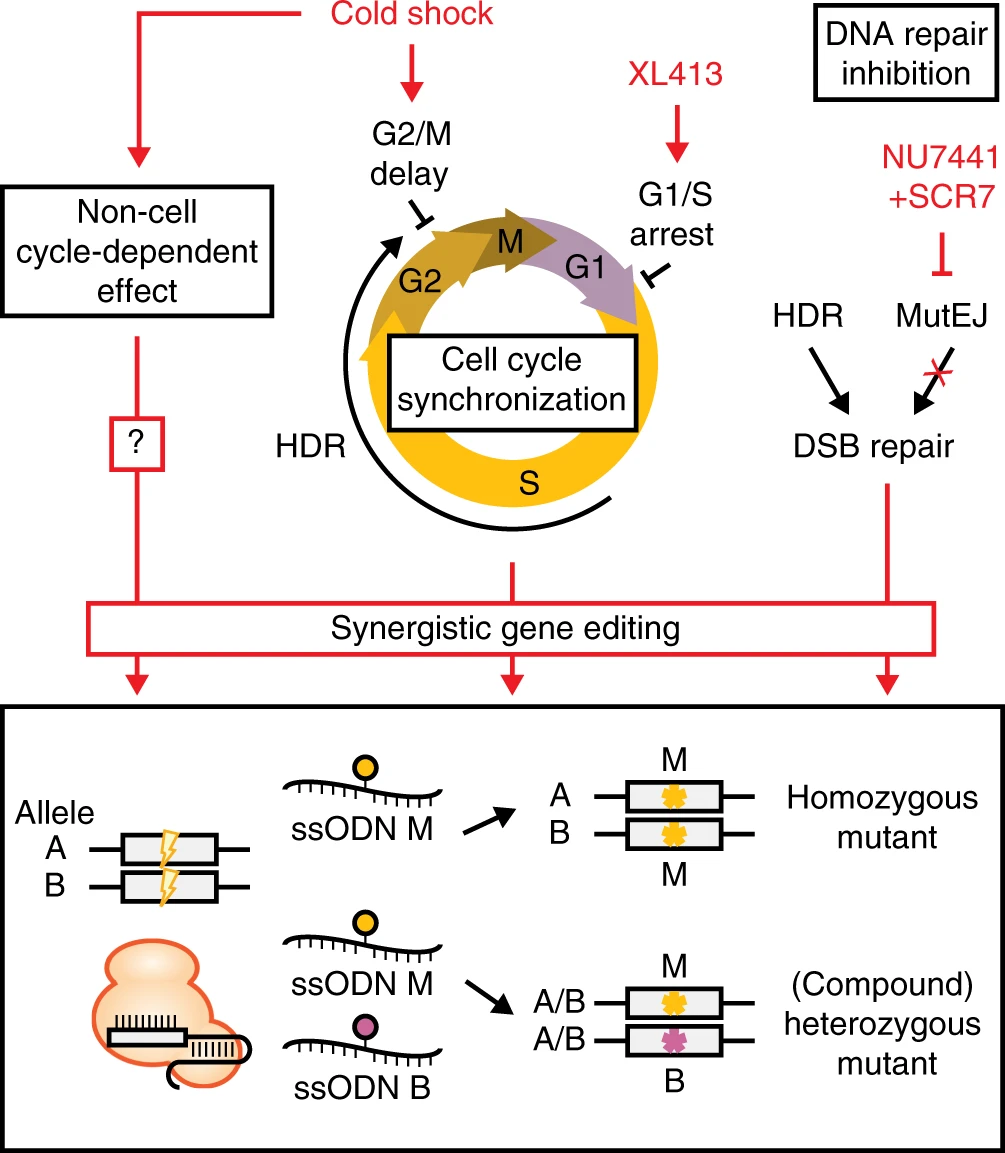Never miss an update from Larisa Sheloukhova
Create your free account to connect with Larisa Sheloukhova and thousands of other innovative organizations and professionals worldwide
The discovery of CRISPR-Cas system for genome editing has revolutionized experimental biology. Research labs all over the world are using multiple variations of the system to answer fundamental questions in genetics, model diseases, and develop therapies. However, precise gene editing to generate single-nucleotide modifications needed for accurate disease modeling and therapeutic development has seen limited success. The Woltjen Lab has developed methods to optimize precise gene editing in iPS cells by combining a series of techniques using CRISPR-Cas9.
Technical Summary
To make single nucleotide modifications,CRISPR-Cas9 is usually used togenerate targeted DNA double-strand breaks in the genome. These are subsequently resolved by the cell’s endogenous DNA repair pathways. Human cells have several strategies to repair double-strand breaks such as non-homologous end joining (NHEJ) and microhomology-mediated end joining (MMEJ), referred to collectively asmutagenic end joining (MutEJ), and homology-directed repair (HDR). Researchers exploit the latter to generate designer, single nucleotide changes: they introduceCRISPR-Cas9 into the cell and provide a customized repair template, i.e. donor plasmid or single-stranded donor oligonucleotide (ssODN), to make the cells repair the breaks using HDR. However, the process is complicated by HDR being limited to specific phases of the cell cycle, while MutEJ is not. This often results in low HDR/MutEJ ratios, i.e. less precise editing.
TheWoltjen Lab optimizedHDR editing with custom ssODN templates by a combination of two techniques: 1) controlling cell-cycle progression with cold shock and 2)modulating DNA repair pathway choice with pharmacological inhibition. For the latter, the researchers treated the cells with various small molecules reported to inhibit particular DNA repair pathway components. As a result, the researchers confirmed improvedHDR rates and HDR/MutEJ ratios and managed to successfully generateboth homozygous and heterozygous mutants of human induced pluripotent stem cells (iPSCs)(Maurissen and Woltjen 2020, Fig.1).

Figure 1.Schematic illustrating precise gene editing approach by releasing the cells into the HDR permissive S and G2 phases of the cell-cycle combined with DNA repair inhibition to improve HDR rates. Additional non-cell-cycle- dependent effects of cold shock may also play a role. Leveraging these mechanisms, homozygous mutations are generated at high efficiency, while heterozygous mutations may be generated without indels by using a combination of mutant and blocking ssODN templates.
The researchers confirmed that their method of gene editing via cell-cycle synchronization and DNA repair pathway modulation is transferable between electroporation instruments and to other iPS cell lines. They are looking for collaborators to apply these techniques to cell lines other than iPSCs and test various pharmaceutical cocktails to find optimal combinations for DNA repair pathway modulation.
Technology Readiness Level
3 - approach has been validated in iPS cell lines
Potential Applications
Disease modeling
Drug screening
Publication(s)
Maurissen TL, Woltjen K. Synergistic gene editing in human iPS cells via cell cycle and DNA repair modulation.Nat Commun 2020; 11: 2876.
Inventors
Knut Woltjen, Ph.D.
Thomas Luc Maurissen, Ph.D.
Intellectual property status
Granted Patent
Patent number : WO2021166306
Where : Japan
Current development status
Laboratory prototypes
Desired business relationship
Technology development
Kyoto University was founded in 1897, the second university to be established in Japan. Kyoto University is among 10 National Designated Universities in Japan. It boasts 18 graduate schools, 10 faculties, 12 research institutes, and 26 centers and other establishments. Research conducted at Kyoto University spans the full spectrum of fields from social to natural science.
The outstanding research conducted at Kyoto University gives birth to useful technologies that could greatly benefit society. IAC (Office of Institutional Advancement and Communications) was established at Kyoto University to bridge the gap between researchers and industry. We facilitate joint research, technology transfer, creation of university startups, and provide entrepreneurial education. We are building a strong network of global industry partners to make sure basic research reaches the market.
Create your free account to connect with Larisa Sheloukhova and thousands of other innovative organizations and professionals worldwide
Send a request for information
to Larisa
Technology Offers on Innoget are directly posted
and managed by its members as well as evaluation of requests for information. Innoget is the trusted open innovation and science network aimed at directly connect industry needs with professionals online.
Need help requesting additional information or have questions regarding this Technology Offer?
Contact Innoget support